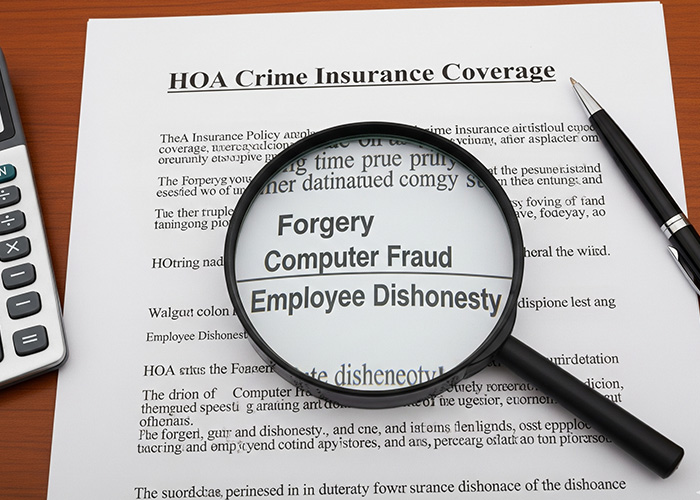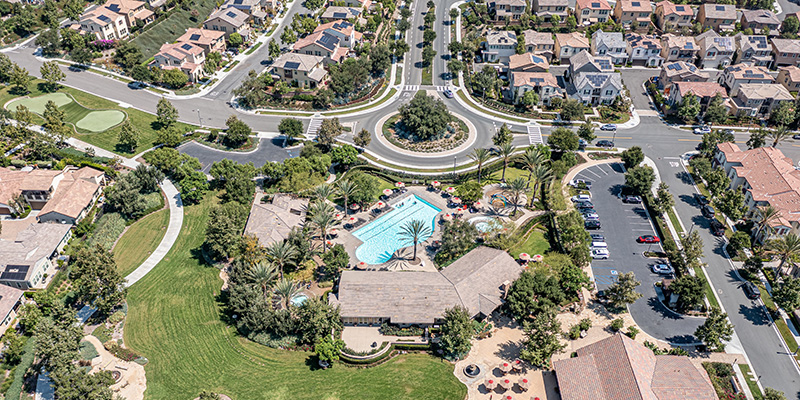Will Your HOA Benefit From HOA Crime Insurance?
Homeowners’ associations handle real money every day. Bank accounts, reserve transfers, vendor payments, and owner assessments all pass through the community’s books. That is why many boards look at HOA crime insurance to protect those funds. The goal is simple. If theft or fraud happens, the association has a safety net.
What is HOA Crime Insurance?
HOA crime insurance is a first-party policy that helps reimburse the association when money or securities are stolen through dishonest acts or fraud. It is sometimes called fidelity or employee dishonesty coverage, but modern policies reach beyond employee theft.
A crime insurance policy can respond to loss caused by board members, committee volunteers, the property manager, and outside parties, depending on how it is written.
Typical HOA Crime Insurance Coverage

Policy forms vary, so always review your declarations and endorsements with your broker. In general, HOA crime insurance can include:
- Employee or volunteer dishonesty that results in theft of money, securities, or property
- Forgery or alteration of checks and drafts
- Computer fraud that manipulates your systems to move funds
- Funds transfer fraud, where criminals trick the bank into sending money
- Social engineering fraud by endorsement, such as a convincing email that imitates a manager or board officer
Pay close attention to how the policy defines “employee.” Many HOAs add endorsements to ensure that board members, committee members, and management company staff are qualified for coverage.
What It Doesn’t Cover
Since it usually covers financial matters, you need to remember that crime insurance is not a catch-all.
For one, it does not address bodily injury or property damage, which sit under general liability, and it does not resolve governance disputes, which belong under Directors and Officers coverage.
Additionally, cyber liability, such as privacy claims or system outages, needs a separate policy unless your HOA crime insurance policy adds a specific endorsement. Loss that predates the policy period, falls outside the discovery window, or stems from errors without theft is also commonly excluded.
How Much HOA Crime Coverage Do You Need?

The correct limit should match your true exposure. Your HOA can start by looking at three figures: your peak bank balance across operating and reserve accounts, your maximum single-day transfer, and the funds accessible to any one person with signing or online authority.
Many boards select a limit at least equal to peak operating cash plus reserves, while others tie the limit to the largest expected transfer.
The final decision should weigh premiums, deductibles, endorsements, and any lender or governing document requirements. With this, your board should review limits each year because reserve balances and project plans change.
Policy Structure
A strong HOA crime insurance setup lists the association as the insured, and it clearly addresses the role of the management company.
When applying for insurance, ask your broker to extend the “employee” definition to include board and committee members, key volunteers, and management company staff who handle your money.
You may also choose to include faithfulness or faithful performance endorsements for individuals in positions of trust. For these, discovery forms are preferred so that losses discovered during the policy period can be addressed, subject to the terms.
Practical Controls That Lower Risk

Effective controls make theft more difficult and losses smaller. Think of them as everyday habits that support your HOA crime insurance rather than a one-time checklist.
Here’s what you need to keep in mind:
- Require two approvals for every payment above a set threshold
- Use Positive Pay and ACH blocks or filters with your bank
- Segregate duties so the person who reconciles accounts cannot issue checks
- Reconcile monthly and review bank statements directly, not copies
- Call vendors using a known number before changing payment details
- Use a lockbox or online portal for owner assessments
However, do remember that controls don’t replace insurance. Instead, they help prevent and detect problems earlier, which limits the size of any loss.
Questions to Ask Your Broker
A good HOA crime insurance policy should align with your community’s financial management practices. When you meet your broker, use these questions to guide the conversation so you can compare quotes on equal terms:
- Does the employee definition extend to board and committee members, and to management company staff who handle our funds?
- Are social engineering and funds transfer fraud included, or available by endorsement?
- Is the form discovery or loss sustained, and what discovery period applies after cancellation?
- Are limits separate for each insuring agreement, or shared under one aggregate?
- How will the deductible apply if several parts of the policy respond to the same event?
- Can limits be increased temporarily when a large reserve project is scheduled?
Bring recent bank statements, your governing documents, and the management agreement to the review. Clear paperwork speeds quoting and helps the board see which policy actually fits.
When HOA Crime Insurance Adds Clear Value
Having a broader HOA crime coverage is helpful when the association holds large reserves. It also benefits the association when one person has wide control over banking and payments or when vendor payments run high.
Other than that, having a crime insurance policy also matters during manager transitions or software changes, since workflows shift and errors are more likely. In these cases, a single event can strain the budget, and HOA crime insurance limits the financial damage.
When Minimal Coverage Might Be Enough
Some smaller communities keep simple finances, hold modest balances, and use strong bank controls. Payments are infrequent, dual approvals are built into the process, and monthly reconciliations are a routine part of the process. In those settings, a lower limit may be reasonable, as long as the board documents the logic and revisits the decision each year.
Yearly Program Review

Treat the annual budget cycle as your cue to review HOA crime insurance. The aim is to align coverage with the expected flow of money in the coming year.
You can start by updating your operating and reserve balances and noting any large projects. This lets you show that its limits reflect real exposure.
Next, confirm that endorsements still fit after renewals or management changes, and walk through basic controls to ensure they work as intended.
Finally, verify the contact information for the carrier and agent, and keep it readily accessible so that the treasurer and president can reach them quickly if an issue arises.
Protecting Your Community
HOA crime insurance cannot stop theft, but it can keep a bad day from becoming a crisis. When coverage, limits, and controls work together, the association protects the money entrusted to it. A brief annual review ensures the plan remains aligned with your budget and projects.
Need efficient management solutions for your HOA community? Condo Manager provides a trusted and reliable community association management platform for self-managed associations and HOA management companies. Reach us online or call us today at (800) 626-1267 to learn more!
Related Articles:






 Many states require businesses to have insurance coverage for workers’ compensation. It often becomes mandatory when a business employs a certain number of people. However, some states require it even if a business hires only one person. For instance, the
Many states require businesses to have insurance coverage for workers’ compensation. It often becomes mandatory when a business employs a certain number of people. However, some states require it even if a business hires only one person. For instance, the  The cost of this insurance policy varies per insurance company. It also varies depending on several factors, including an HOA’s size, job types, and the number of volunteers and employees. Insurance providers also look at the HOA’s past records to see how often workplace illnesses and injuries occur. This can increase the premium cost they charge.
The cost of this insurance policy varies per insurance company. It also varies depending on several factors, including an HOA’s size, job types, and the number of volunteers and employees. Insurance providers also look at the HOA’s past records to see how often workplace illnesses and injuries occur. This can increase the premium cost they charge.
 Directors and Officers (D&O) liability insurance is among the most important HOA insurance policies. It essentially protects the board of directors from various lawsuits and settlements against them.
Directors and Officers (D&O) liability insurance is among the most important HOA insurance policies. It essentially protects the board of directors from various lawsuits and settlements against them. Many HOA insurance policies have limitations. If you want to go beyond these limits, you can also purchase Commercial Umbrella Liability Coverage. This helps you stay protected when your D&O or Workers’ Compensation policy can’t cover the costs. The umbrella may also expand your coverage on other policies.
Many HOA insurance policies have limitations. If you want to go beyond these limits, you can also purchase Commercial Umbrella Liability Coverage. This helps you stay protected when your D&O or Workers’ Compensation policy can’t cover the costs. The umbrella may also expand your coverage on other policies.
 General Liability. This includes expenses that the HOA may incur when there’s a lawsuit against the association. For example, someone may get injured within HOA property and hold the homeowners’ association liable. In such cases, your HOA insurance policy will cover the costs.
General Liability. This includes expenses that the HOA may incur when there’s a lawsuit against the association. For example, someone may get injured within HOA property and hold the homeowners’ association liable. In such cases, your HOA insurance policy will cover the costs. What If Your HOA Insurance Doesn’t Have Sufficient Coverage?
What If Your HOA Insurance Doesn’t Have Sufficient Coverage?
 Both homeowners’ associations and condominium associations need liability insurance. But, an HOA policy insurance for a condo will differ slightly in how it works.
Both homeowners’ associations and condominium associations need liability insurance. But, an HOA policy insurance for a condo will differ slightly in how it works. nsurance policies like these vary greatly in terms of cost. It usually depends on how large the HOA is and how many facilities it has. Larger communities with more amenities can expect to pay more. Meanwhile, smaller communities have less to pay for. They may only need to insure the basics like roads and walkways.
nsurance policies like these vary greatly in terms of cost. It usually depends on how large the HOA is and how many facilities it has. Larger communities with more amenities can expect to pay more. Meanwhile, smaller communities have less to pay for. They may only need to insure the basics like roads and walkways.
